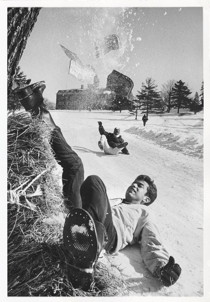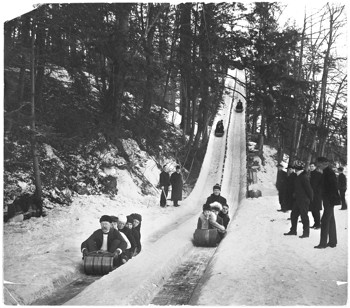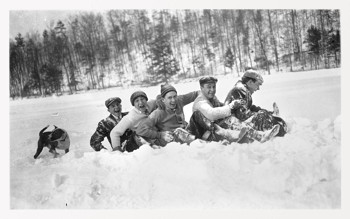CORNELL HISTORY

Ice skating on Beebe Lake, early 1900s. Image courtesy of the Division of Rare and Manuscript Collections.
Cornellians at play, in winter's snow and ice

Tray sliding on Libe Slope, ca. 1960s (this practice was banned around 1970 for safety reasons). Image courtesy of the Division of Rare and Manuscript Collections. See larger image
To most Cornellians today, winter in Ithaca means subzero temperatures, bundling up in jackets and scarves, Big Red hockey, and occasional hikes to class through two feet of snow. But for earlier generations, East Hill was home to an alternate array of winter activities and traditions.
Ice hockey at Cornell was a much different affair before the opening of Lynah Rink in 1957. The men's ice hockey team played its first intercollegiate game in 1901 against Swarthmore, but the early years were limited to neutral or away locations. It wasn't until 1907 that an outdoor rink was set up on Beebe Lake (the first game: a 7-0 victory over Rochester). Much of the early winter activity on Beebe Lake was thanks to Johnny Parsons, an engineering professor who encouraged ice skating by securing the funds, equipment and staff to clear snow from the lake. As the lake's popularity increased, temporary shelters were built, and the Johnny Parson's Club opened in 1922 as a warming house and eatery for skaters. Through renovations and reconstructions, the building became Japes Lodge, which housed the Cornell Outing Club until 2012 when the then-dilapidated structure was declared unsafe.
For those not on skates, perhaps the most popular winter activity for the first half of the 20th century was the Beebe Lake toboggan slide, which operated from 1902-49. The large wooden slide (replaced by steel in 1912) sent Cornellians hurtling down the south shore of Beebe Lake onto the ice at high speeds. Not limited to students, the very first toboggan to use the slide allegedly included Dean "Tee Fee" Crane and then-President Jacob Gould Schurman among its passengers. The slide was eventually dismantled, in part because of the various serious injuries it caused (seven fractured vertebrae reported in 1940 alone), but also because of gradually decreasing activity on Beebe Lake as skiing and other alternatives became more popular. Today, the Toboggan Lodge on Forest Home Drive houses offices.

The toboggan slide on Beebe Lake, early 1900s. Image courtesy of the Division of Rare and Manuscript Collections. See larger image
Cornell owned and operated its own ski center for more than a decade, opening the facility in 1942 in the Caroline hills about 10 miles outside Ithaca. Named Tar Young Hill in honor of physical education professor Charles "Tar" Young, Class of 1899, the center included its own ski lift and ski jump. Skiing was a varsity sport at the time, and the team used the center for practice and intercollegiate competition. The center was closed in the late 1950s.
From 1905 until the '40s, a staple of the January break between semesters (the now-defunct "Junior Week") was an annual Ice Carnival. The traditional event usually included choreographed skating, ice sculpture contests, music, games, sideshows and more. Unfortunately, the unpredictability of Ithaca weather meant it was often postponed or canceled. After a hiatus during World War II, the Ice Carnival made a brief comeback, but then faded away in the next few years along with Junior Week itself.

Students and a dog after a toboggan ride, ca. 1920s-'30s. Image courtesy of the Division of Rare and Manuscript Collections. See larger image
One winter tradition still shared by generations of Cornellians is sledding down the steep slopes on and around Cornell's campus. Although Buffalo Street is no longer closed for sledding as it was occasionally during the winters a century ago, a sudden blizzard still brings throngs of students to Libe Slope. The tradition of "tray racing" (sledding on dining hall trays) appears to have originated in late 1940s, eventually called "tray sliding" and shortened to "traying" by the 1970s. Although official Libe Slope sledding and skiing hours were set by the university in the 1950s and '60s, the practice was banned for safety reasons around 1970. And with the transition to "trayless" dining at Cornell, beginning in 2009 as part of a sustainability initiative, students can no longer "borrow" the makeshift sleds from Willard Straight Hall dining facilities. Sledding on the slope remains prohibited, but the Cornell Plantations offers safer alternatives.
Despite Ithaca's reputation for challenging and character-building winters, Cornellians have always found ways to adapt and enjoy the chilly weather. Traditions may come and go, but students can depend on the seasons to change and the snow to fall.
Corey Ryan Earle '07 is associate director of student programs in Cornell's Office of Alumni Affairs.